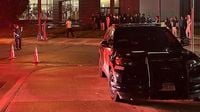On Thursday evening, September 18, 2025, two major U.S. university campuses experienced alarming incidents that left students, faculty, and local communities on edge. In Ann Arbor, Michigan, a stabbing near the University of Michigan’s medical complex sparked a manhunt, while in Minneapolis, Minnesota, gunshots rang out near Rapson Hall at the University of Minnesota, sending waves of anxiety through a crowd of hundreds gathered for a student event.
According to the University of Michigan Division of Public Safety & Security (U-M DPSS), the stabbing occurred at approximately 6:20 p.m. near the intersection of Catherine Street and Zina Pitcher Place. The area, a busy corridor bordering the university’s hospital and academic buildings, was quickly cordoned off as emergency responders arrived on the scene. U-M DPSS released a photograph of the suspect, described as a Black man wearing a white shirt, tie, and jeans. The department urged the public to avoid the area and to call 911 immediately if the suspect is seen. "We are doing everything in our power to apprehend the individual responsible and ensure the safety of our community," a U-M DPSS spokesperson said, echoing the urgency felt across campus.
While details about the victim’s condition were not immediately available, the incident rattled students and staff, many of whom expressed concern about safety in an area typically bustling with foot traffic and medical personnel. The university’s alert system was activated, sending notifications to thousands urging vigilance and caution. The swift response by public safety officers underscored the seriousness with which the university treats violent incidents, especially in light of national conversations about campus security.
Meanwhile, nearly 700 miles away in Minneapolis, a different kind of crisis was unfolding. Around the same time as the Ann Arbor stabbing, two gunshots were heard near Rapson Hall on the University of Minnesota campus. The shots were so distinct that a KARE 11 reporter and photographer, present on campus, confirmed hearing them firsthand. According to KARE 11, the University of Minnesota Police Department (UMPD) responded within moments, searching the area with guns drawn in search of potential suspects.
The university quickly posted a safety alert on its website, informing the campus community that no injuries had been reported but that police were actively searching for suspects. The timing of the incident was particularly alarming: approximately 300 students were gathered in Rapson Hall for a student group event when the shots rang out. "Hearing gunfire so close to where so many of us were gathered was terrifying," one student, who asked not to be named, told KARE 11. "We just tried to stay calm and wait for instructions."
Authorities have not yet released descriptions of any suspects or clarified whether the shots were fired in connection with the student event. However, the rapid deployment of officers and the visible increase in security presence on campus reflected the heightened state of alert. The university’s messaging emphasized that while no physical injuries occurred, the psychological impact on students and staff was significant. Many spent the evening anxiously checking for updates and communicating with loved ones to assure them of their safety.
Both incidents highlight the complex challenges facing university security forces in the current climate. With campuses serving as microcosms of broader society, they are not immune to the violence and unpredictability that can strike any community. In Ann Arbor, the stabbing near the heart of the university’s medical district raised questions about access, surveillance, and the ability of campus police to respond to rapidly evolving threats. In Minneapolis, the presence of gunfire during a large student gathering underscored concerns about weapons on campus and the protocols in place to protect students during emergencies.
For students and faculty at both universities, Thursday’s events were a stark reminder of the importance of vigilance and the value of robust emergency communication systems. The University of Michigan’s immediate request for the public to avoid the area and call 911 if the suspect was seen demonstrated a clear and decisive approach to crisis management. Similarly, the University of Minnesota’s quick publication of a safety alert and visible police response helped prevent panic and provided reassurance, even as details remained scarce.
These incidents also reignited discussions about campus safety measures nationwide. Many universities have invested heavily in alert systems, surveillance cameras, and increased patrols, but the events in Ann Arbor and Minneapolis show that even the best-prepared institutions can be tested by sudden acts of violence. "We always hope these systems are never needed, but when they are, it’s critical that they work as intended," said a campus security analyst familiar with university protocols. "The goal is to minimize harm and restore a sense of safety as quickly as possible."
As of Friday morning, authorities in Ann Arbor were still searching for the stabbing suspect. The University of Michigan community remained on high alert, with students sharing the suspect’s description and photo across social media in hopes of assisting the investigation. In Minneapolis, police continued their search for suspects connected to the gunfire, while university officials reviewed security footage and gathered witness statements to piece together what happened. Both universities promised to update their communities as new information became available.
For now, the focus in both cities is on healing and prevention. Counseling services have been made available to students and staff affected by the incidents, and university leaders have reiterated their commitment to safety. As the investigations continue, communities in Ann Arbor and Minneapolis are left grappling with the aftershocks of two frightening evenings, hopeful that swift action by authorities will bring resolution and restore peace of mind.
Thursday’s events serve as a sobering illustration of the unpredictable realities facing America’s campuses, where the pursuit of knowledge can be disrupted in an instant. As students return to classes and routines, the memory of these incidents lingers—a call to remain vigilant, support one another, and demand ongoing attention to campus safety from leaders at every level.
